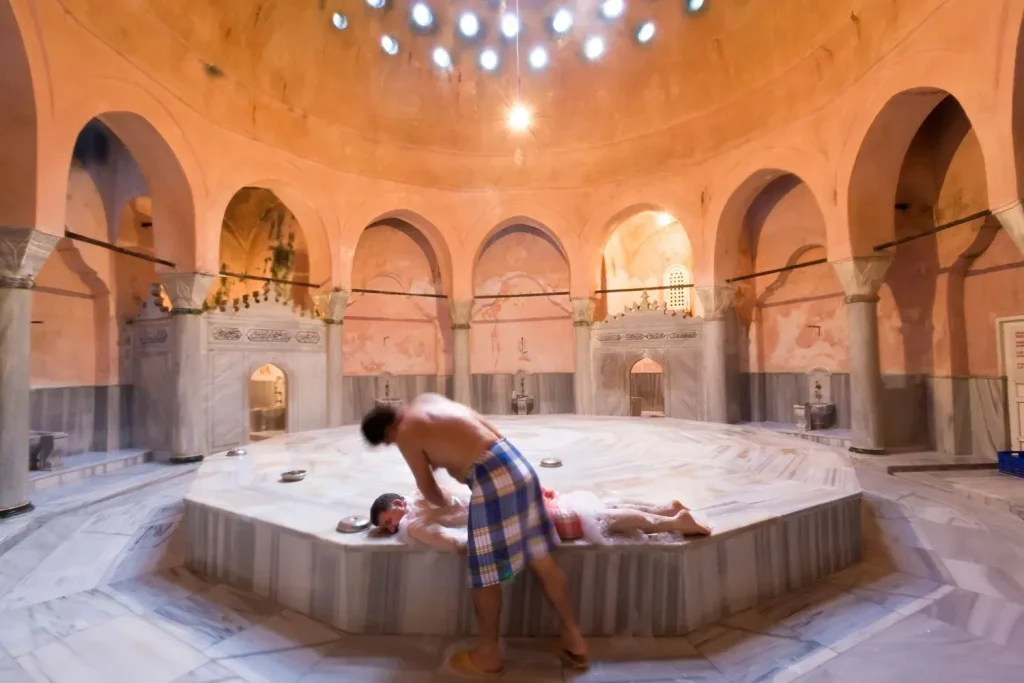The Cultural Significance of the Traditional Hamam
The Traditional Hamam is far more than a place to cleanse the body—it is a cultural institution with roots going back centuries. Emerging from the Roman and Byzantine bathhouse model and refined through the Ottoman Empire, the Traditional Hamam became a central part of daily life, used for socializing, spiritual preparation, and ceremonial occasions like weddings and religious festivals.
How the Traditional Hamam Works
A visit to a Traditional Hamam is structured around a series of stages. Guests begin by relaxing in a warm steam room to open their pores and begin the detoxification process. The heart of the Traditional Hamam experience is the scrubbing ritual, where an attendant uses a kese mitt to exfoliate dead skin. This is followed by a rich soap massage and thorough rinsing. The ritual concludes with rest and rehydration in a cool lounge area.
Health Benefits of the Traditional Hamam
The Traditional Hamam offers numerous benefits for both body and mind. Regular exfoliation improves skin health and glow, while steam helps ease respiratory issues and promotes circulation. For many, the Traditional Hamam is also a mental reset—its calming rhythm helps reduce anxiety, stress, and fatigue. It’s a wellness solution rooted in simplicity, heat, water, and care.
Design and Architecture of a Traditional Hamam
The structure of a Traditional Hamam is specifically built to enhance the ritual. With domed ceilings, marble interiors, central heated platforms, and symmetrical rooms, every design element in a Traditional Hamam contributes to the physical and emotional comfort of its guests. These spaces are as beautiful as they are functional, intended to inspire tranquility and privacy.
What to Expect During a Traditional Hamam Visit
If it’s your first time in a Traditional Hamam, you can expect a peaceful, structured experience. Most facilities provide towels, slippers, and pestemal wraps. An attendant will guide you through each phase of the ritual. You don’t need prior experience—just an openness to surrender to the pace of the Traditional Hamam and enjoy the full-body renewal it provides.
The Revival of the Traditional Hamam in Modern Times
In recent years, the Traditional Hamam has seen a resurgence in popularity as people seek authentic, natural wellness experiences. From Istanbul to wellness spas around the world, the Traditional Hamam is now recognized not only for its historical value but also for its role in modern self-care. It’s a living tradition that continues to adapt while preserving its ancient roots.
Conclusion
The Traditional Hamam stands as a bridge between ancient rituals and modern wellness. Its value goes beyond relaxation—offering deep physical cleansing, emotional peace, and cultural immersion. For those seeking balance, authenticity, and rest, the Traditional Hamam remains an unmatched sanctuary of healing and heritage.
Frequently Asked Questions
- What makes a hamam “traditional”?
A Traditional Hamam follows historical rituals, architecture, and multi-phase cleansing rooted in Ottoman-era practices. - Is the Traditional Hamam suitable for sensitive skin?
Yes, the Traditional Hamam can be adjusted for sensitive skin—inform your attendant before exfoliation. - What should I wear inside a Traditional Hamam?
A pestemal wrap is commonly worn in a Traditional Hamam, and most spas provide one for guests. - Are men and women separated in the Hamam?
Most Traditional Hamam facilities have separate sections or hours for men and women. - Do I need to bring my own towel?
No, a Traditional Hamam will typically provide towels, sandals, and soap for your session. - Is tipping expected in a Traditional Hamam?
Yes, it’s customary to tip your attendant in a Traditional Hamam, especially for scrubbing and massage services. - How long does a Traditional Hamam session last?
A full Traditional Hamam visit usually takes between 60 and 90 minutes, depending on the package. - Can I visit a Traditional Hamam while pregnant?
Consult a doctor first. Some phases of the Traditional Hamam may not be suitable during pregnancy due to heat exposure. - Do I need to speak Turkish to visit a Hamam in Turkey?
No, many Traditional Hamam attendants speak basic English, especially in tourist areas. - Can I enjoy the Traditional Hamam alone?
Absolutely. The Traditional Hamam is often a solo, introspective experience enjoyed in silence and calm.
